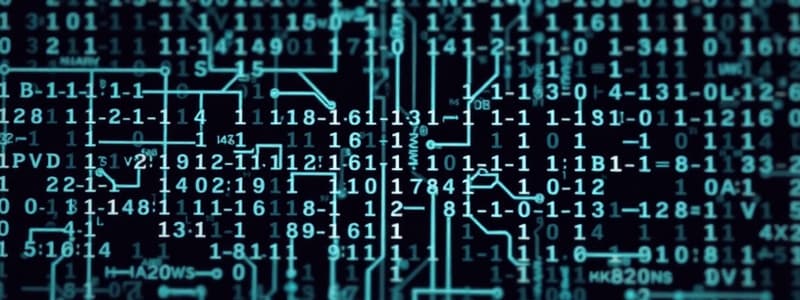Podcast
Questions and Answers
What does a parity bit do in error detection?
What does a parity bit do in error detection?
- It stores additional information about the data.
- It checks whether the number of 1s is even or odd. (correct)
- It corrects errors in data transmission.
- It adds an extra digit to increase the data size.
In the context of combinational circuits, which of the following best describes a characteristic feature?
In the context of combinational circuits, which of the following best describes a characteristic feature?
- It has memory elements for storing states.
- It can function independently of inputs.
- The output is determined by the previous input states.
- The output depends solely on the current inputs. (correct)
Which of the following correctly describes a Full Adder?
Which of the following correctly describes a Full Adder?
- It requires two inputs and produces two outputs.
- It adds two bits along with a carry-in to produce a sum and a carry-out. (correct)
- It is a type of multiplexer used for addition.
- It can only add two single-bit numbers.
What distinguishes an encoder from a decoder?
What distinguishes an encoder from a decoder?
What is a multiplexer used for in digital circuits?
What is a multiplexer used for in digital circuits?
Flashcards
Truth Table
Truth Table
A truth table is a visual representation of a Boolean function. It lists all possible combinations of input values and their corresponding output values.
Parity Bits
Parity Bits
Parity bits are extra bits added to a data word to detect errors during transmission. They ensure the total number of 1's in a data word (including the parity bit) is even or odd, depending on the parity scheme.
BCD Code
BCD Code
BCD (Binary Coded Decimal) is a binary code that represents each decimal digit (0-9) with a 4-bit binary code. This code is used in systems that require interaction with decimal-based data, like calculators.
Combinational Circuit
Combinational Circuit
Signup and view all the flashcards
Multiplexer
Multiplexer
Signup and view all the flashcards
Study Notes
BCA Examination 2022 - Logical Organization of Computer
- Exam: First Semester, BCA-104
- Time: 3 hours
- Marks: 80
- Instructions: Attempt 5 questions, equal marks for each
- Note: Candidates must ensure correct and complete question paper is supplied, complaints will not be entertained after the examination.
Unit I
- Question 1(a): Describe Truth Table.
- Question 1(b): Explain Multilevel NAND circuit.
- Question 1(c): Write a short note on Parallel Binary Adder.
- Question 1(d): What is Digital Signal?
- Question 1(e): Explain Karnaugh Maps.
- Question 1(f): Describe Standard SOP form of Boolean function.
- Question 1(g): What is Unicode? Describe it.
- Question 1(h): Describe Full Adder.
Unit II
- Question 2(a): What are parity bits? How are they relevant in error detection and correction code? Explain with example.
- Question 2(b): Explain Floating point representation of number and character codes.
- Question 3(a): Explain the BCD code in detail. Also, explain why these codes are used.
- Question 3(b): Explain error detection and correction codes.
Unit III
- Question 4(a): Simplify the Boolean expression F(a, b, c) = Σ(1, 4, 5, 6, 7) using K-Map and realize the same using NAND gates.
- Question 4(b): Explain canonical and standard form of Boolean function.
- Question 5(a): Explain SOPs and POSs.
- Question 5(b): Describe Venn Diagram and Boolean Algebra.
Unit IV
- Question 6(a): Explain AND-OR-INVERT and OR-AND-INVERT implementation.
- Question 6(b): What is combinational circuit? Describe its characteristics and procedure for design.
Unit V
- Question 7(a): Design a combinational circuit that receives 2-bit binary input and produces its square at the output.
- Question 7(b): What is a Universal Gate? Why are these named so? Justify.
- Question 8(a): What is a multiplexer? How does it work? What are its applications? Explain.
- Question 8(b): What is Half Adder and Full Adder? Design a full adder and implement the same using gates.
- Question 9(a): Explain the principle of encoder and decoder; how are they different?
- Question 9(b): What are comparators? Where are they used? Describe the types.
Studying That Suits You
Use AI to generate personalized quizzes and flashcards to suit your learning preferences.



